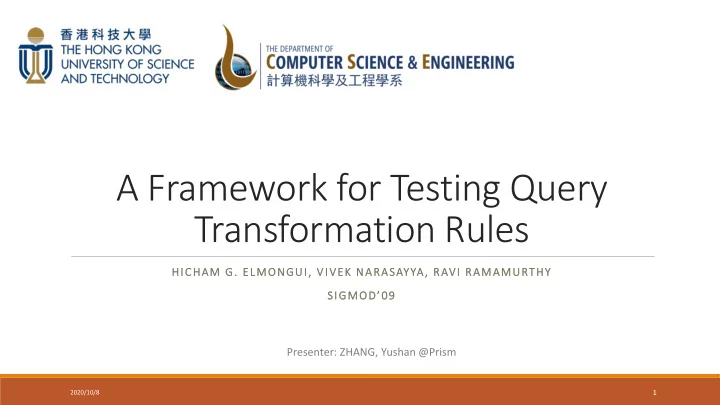

A Framework for Testing Query Transformation Rules HICHAM G. ELMONGUI, VIVEK NARASAYYA, RAVI RAMAMURTHY SIGMOD’09 Presenter: ZHANG, Yushan @Prism 1 2020/10/8
Outline ➢ Background of this research ➢ The Challenges ➢ Framework Design ➢ Experiment ➢ Reflections 2 2020/10/8
Background Query Optimization: Overview Two Requirements: ➢ Produce faster plans ➢ Guarantee correct results https://docs.oracle.com/database/121/TGSQL/tgsql_optcncpt.htm#TGSQL196 3 2020/10/8
Background Transformation Rule: example Let 𝐹 denote a relational algebra expression, 𝜄 is a predicate E.g. 𝜏 𝜄 1 ∧𝜄 2 𝐹 ≡ 𝜏 𝜄 1 (𝜏 𝜄2 𝐹) , a cascade of 𝜏 𝐹 1 ⋈ 𝜄 𝐹 2 ≡ 𝐹 2 ⋈ 𝜄 𝐹 1 , theta-join is commutative Database System Concepts , 7 th edition. P747-751 4 2020/10/8
Background Testing Aspects ➢ Coverage ➢ a given transformation rule ( rule ) should be executed with different queries ➢ Correctness ➢ a given transformation rule should NOT alter the results of a query ➢ a pair of transformation rules should NOT alter the results of a query ➢ Performance… (not considered in this paper) 5 2020/10/8
The Background Challenges The Challenges ➢ Efficiently generate queries that exercise a particular rule (Generation Problem) ➢ Randomly generation [1][2] takes many trials before find a query - slow ➢ Randomly generated queries are hard to interpret - complex ➢ Efficiently execute test suites for correctness testing (Compression Problem) ➢ Intuitive approach: turn off the rules one by one, and compare the results ➢ Problem: un-optimized queries could be extremely slow [1] H. Bati, L. Giakoumakis, S.Herbert, A.Surna. A genetic approach for random testing of database systems. Proceedings of VLDB 2007. 6 2020/10/8 [2] D.Slutz, Massive Stochastic Testing of SQL. Proceeding of VLDB 1998.
The Background Approach Challenges Generation with Rule Patterns ➢ Captures the sufficient condition for a rule to execute is hard ➢ Pull up GBAgg requires certain functional dependency ➢ Use Rule Patterns ( necessary condition ) ➢ A query exercising the given rule must have the corresponding pattern ➢ Initialize the “wholes” in the pattern ➢ Support rule composition (extends to test multiple rules) Take-away message: ➢ reduce the trials with known necessary conditions 7 2020/10/8
The Background Approach Challenges Test Suite Compression (TSC) ➢ Very high cost for executing the test suite ➢ A query could exercise multiple rules ➢ A rule is exercised by multiple rules and 𝑙 = 1 Intuition ( bipartite graph problem ): A set of transformation rules: 𝑆 = 𝑠 1 , 𝑠 2 , ⋯ 𝑠 𝑈𝑇 1 = {𝑟 1 } 𝑜 𝑈𝑇 2 = {𝑟 2 } A test suite for a rule has 𝑙 queries 𝐷𝑝𝑡𝑢(𝑈𝑇 1 ) = 100 + 180 Overall test suites for R: 𝑈𝑇 =ڂ 𝑗 𝑈𝑇 𝑗 𝐷𝑝𝑡𝑢 𝑈𝑇 2 = 100 + 120 (with cost ) Nodes are rules and queries 𝐷𝑝𝑡𝑢(𝑈𝑇) = 𝐷𝑝𝑡𝑢(𝑈𝑇 1 ) + 𝐷𝑝𝑡𝑢(𝑈𝑇 2 ) (with cost ) Edge from 𝑠 𝑗 to 𝑟 𝑘 denotes 𝑠 𝑗 is exercised when 𝑟 𝑘 is optimized. Goal : Minimize cost of TS Question: what is the optimal solution for this example? Constraint : Each rule is exercised k times 8 2020/10/8
The Background Approach Challenges Test Suite Compression (TSC) ➢ Very high cost for executing the test suite ➢ A query could exercise multiple rules ➢ A rule is exercised by multiple rules and 𝑙 = 1 Intuition ( bipartite graph problem ): A set of transformation rules: 𝑆 = 𝑠 1 , 𝑠 2 , ⋯ 𝑠 𝑈𝑇 1 = {𝑟 1 } 𝑜 𝑈𝑇 2 = {𝑟 2 } A test suite for a rule has 𝑙 queries 𝐷𝑝𝑡𝑢(𝑈𝑇 1 ) = 100 + 180 Overall test suites for R: 𝑈𝑇 =ڂ 𝑗 𝑈𝑇 𝑗 𝐷𝑝𝑡𝑢 𝑈𝑇 2 = 100 + 120 (with cost ) Nodes are rules and queries 𝐷𝑝𝑡𝑢(𝑈𝑇) = 𝐷𝑝𝑡𝑢(𝑈𝑇 1 ) + 𝐷𝑝𝑡𝑢(𝑈𝑇 2 ) (with cost ) Edge from 𝑠 𝑗 to 𝑟 𝑘 denotes 𝑠 𝑗 is exercised when 𝑟 𝑘 is optimized. Optimal solution: 𝐷𝑝𝑡𝑢(𝑈𝑇) = 100 + 120 + 120 9 2020/10/8
The Background Approach Challenges Test Suite Compression (TSC) ➢ Reduction from the Set Cover Problem to TSC (NP-Hard) ➢ Only approximation algorithm is possible ➢ Two algorithms ➢ Applying the Set Cover Heuristic (ignores edge cost) ➢ Constrained Set Multicover algorithms (SMC) ➢ TopKIndependent algorithm (considers edge cost) ➢ Consider edge costs for each rule separately, sort them and use greedy picks ➢ Further optimization to boost the picking process 10 2020/10/8
The Framework Background Challenges Design Framework Overview 11 2020/10/8
The Framework Background Experiments Challenges Design Experiment Setup The approach is prototyped in Microsoft SQL Server Databases: TPC-H Used 30 rules of the optimizer ➢ The efficiency of query generation: random vs. patthern ➢ The effectiveness of two algorithms: SetMultiCover vs. TopKIndependent ➢ The importance of exploiting monotonicity ( further optimization on TopKIndependent ) 12 2020/10/8
The Framework Background Experiments Challenges Design Random vs. Pattern based Generation 13 2020/10/8
The Framework Background Experiments Challenges Design Compression Quality Y-axis: Log scale Optimizer estimated cost 14 2020/10/8
Summary This papers considers the problem of testing transformation rules of a query optimizer Main Contributions: ➢ Efficiently generate queries to cover the given rules ➢ Use query patterns to reduce the random generations trials ➢ Efficiently execute test suites for correctness testing ➢ Use approximation to pick a subset of the queries 15 2020/10/8
Reflections ➢ This paper has a very clean and clear writing style, which worth a detailed reading ➢ There is a well-established logic between the defined problem and the solution ➢ A typical example is used throughout the paper ➢ The approach illustration is simple to understand without the theory 16 2020/10/8
Recommend
More recommend